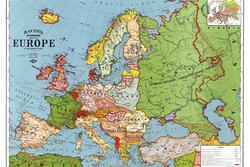What Is Antisemitism?
What is antisemitism? In recent years, this question has become a source of debate. According to the definition adopted by the International Holocaust Remembrance Alliance (IHRA) in 2016, antisemitism is “a certain perception of Jews, which may be expressed as hatred towards Jews.” This definition would appear self-explanatory. The IHRA even provides eleven examples of antisemitism as a guide. But some argue that the IHRA’s definition suppresses debates about Israel by failing to distinguish between antisemitic criticism of Israel and legitimate criticism.
On March 26, 2021, a new definition of antisemitism endorsed by over 200 established scholars of Jewish history, Holocaust studies, and related fields was released in an attempt to clear up the relationship between antisemitism and anti-Zionism. Developed by an international group of academics under the auspices of the Van Leer Jerusalem Institute, the Jerusalem Declaration on Antisemitism (JDA) provides a set of fifteen guidelines on antisemitism alongside a concise definition and preamble. Explicitly framed as an alternative to the IHRA’s “working definition,” the non-legally binding declaration controversially sets a new precedent in allowing for debates about Israel while emphasizing the urgency of combating rising antisemitism.
As antisemitic bigotry continues to escalate in Europe and America, those seeking to tackle it—including researchers of antisemitism and the Holocaust like myself—are searching for new tools in order to identify the discrimination of Jews. Up until now, the IHRA has remained the dominant voice on antisemitism in Europe and North America, and European institutions have been widely encouraged to adopt its limited definition. Last year, the UK education secretary Gavin Williamson even threatened English universities with sanctions if they failed to uphold the definition.
However, the IHRA definition has received backlash from scholars, activists, and left-wing Jews due to its lack of clarity and its conflation of antisemitism with criticism of Israel. According to the JDA, the IHRA definition has “caused confusion and generated controversy”: its status as a working definition gives rise to misinterpretation, and seven out of eleven of its “examples” of antisemitism are underpinned by the implicit assumption that all Jews are Zionists. One of IHRA’s examples states that “Denying the Jewish people their right to self-determination, e.g., by claiming that the existence of a State of Israel is a racist endeavour” is antisemitic. This suggests that for Jewish people, self-determination necessarily means support of Israel, which is not the case for many.
Scholars Aleida Assmann, Alon Confino, and David Feldman, all of whom signed the Declaration, wrote in a recent article for EUobserver that the IHRA definition’s interchangeable use of Judaism and Zionism has “a chilling effect on free speech and academic freedom and distracts from the acute danger of far-right antisemitism. Instead of unifying people in order to combat antisemitism, the IHRA has unfortunately become highly divisive.” The IHRA definition leaves room for the weaponization of antisemitism for political ends, which both diverts attention away from combatting antisemitic discrimination and fails to protect Jews engaged in debates about Israel-Palestine. By offering “clear guidance to identify and fight antisemitism while protecting free expression,” the JDA seeks to rectify these issues.
The document provided by the JDA defines antisemitism as “discrimination, prejudice, hostility, or violence against Jews as Jews (or Jewish institutions as Jewish).” The accompanying preamble stresses the intersectional nature of the fight against antisemitism, which is “inseparable from the overall fight against all forms of racial, ethnic, cultural, religious, and gender discrimination.” It also emphasizes that the declaration is “not seeking to promote a partisan political agenda,” but rather to provide a safe space for an “open” conversation about Israel-Palestine.
The guidelines of the declaration are split into three parts: Part A contains five general guidelines on antisemitism, and parts B and C each contain five guidelines on Israel and Palestine. The former part provides “examples that, on the face of it, are antisemitic,” including “Holding Jews collectively responsible for Israel’s conduct or treating Jews, simply because they are Jewish, as agents of Israel”. The latter part offers “examples that, on the face of it, are not antisemitic,” such as “supporting the Palestinian demand for justice and the full grant of their political, national, civil and human rights, as encapsulated in international law.” These distinctions are important, as they offer a context-specific framework for identifying when criticism of Israel amounts to antisemitism, and when it does not.
The preamble offers the following example to show the importance of “judgement and sensitivity” when applying JDA guidelines to “concrete situations”: “Hostility to Israel could be an expression of an antisemitic animus, or it could be a reaction to a human rights violation, or it could be the emotion that a Palestinian person feels on account of their experience at the hands of the State.” This example demonstrates the often complex discourse and high stakes surrounding discussions of Israel, as well as the importance of critically separating Judaism from Zionism for both Jewish and Palestinian people.
Yet some scholars of antisemitism and the Middle East have raised concerns about the JDA due to its inadvertent reproduction of the IHRA definition’s emphasis on Israel. Sai Englert, lecturer in the political economy of the Middle East at Leiden University, argues that the declaration fails to explicitly acknowledge the “international threat of a rapidly growing far right as the principal danger facing Jewish communities everywhere.”
The JDA makes important distinctions between antisemitism and anti-Zionism, but the declaration still centers Israel, not white nationalism. Nationalistic right-wing governments and political movements perpetuate the violent treatment of racial and religious minorities and undermine democracy by fostering extremist views. Countries like Poland and Hungary are increasingly engaging in state-sponsored attempts to revise local histories of antisemitism to legitimize racial bigotry in the present. Meanwhile, in France and Germany, antisemitic attacks on synagogues and other acts of hate have risen sharply over the last two decades. These are not isolated incidents, but are part of a broader trend in antisemitic discrimination targeting Jewish populations everywhere.
As Medium writer Em Cohen Tweeted recently, “Defining antisemitism doesn’t stop it,” and there is a danger that conversations about how best to characterize antisemitism take away from confronting the everyday discrimination faced by Jews. However, by treating antisemitism as a serious manifestation of racial inequality while protecting freedom of expression, the JDA is a step towards challenging it.






